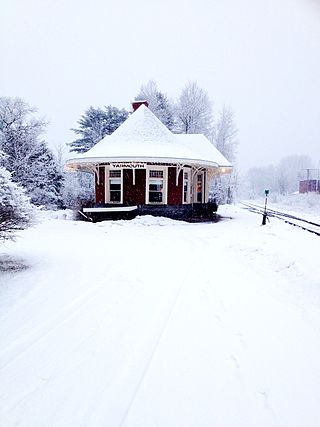
The Grand Trunk Railway was a railway system that operated in the Canadian provinces of Quebec and Ontario and in the American states of Connecticut, Maine, Michigan, Massachusetts, New Hampshire, and Vermont. The railway was operated from headquarters in Montreal, Quebec, with corporate headquarters in London, United Kingdom. It cost an estimated $160 million to build. The Grand Trunk, its subsidiaries, and the Canadian Government Railways were precursors of today's Canadian National Railway.
The Central Vermont Railway was a railroad that operated in the U.S. states of Connecticut, Massachusetts, New Hampshire, New York, and Vermont, as well as the Canadian province of Quebec.

The St. Lawrence and Atlantic Railroad, known as St-Laurent et Atlantique Quebec in Canada, is a short-line railway operating between Portland, Maine, on the Atlantic Ocean, and Montreal, Quebec, on the St. Lawrence River. It crosses the Canada–US border at Norton, Vermont, and Stanhope, Quebec, and is owned by short-line operator Genesee & Wyoming.

The Boston and Lowell Railroad was a railroad that operated in Massachusetts in the United States. It was one of the first railroads in North America and the first major one in the state. The line later operated as part of the Boston and Maine Railroad's Southern Division.

The Maine Central Railroad was a U. S. class 1 railroad in central and southern Maine. It was chartered in 1856 and began operations in 1862. By 1884, Maine Central was the longest railroad in New England. Maine Central had expanded to 1,358 miles (2,185 km) when the United States Railroad Administration assumed control in 1917. The main line extended from South Portland, Maine, east to the Canada–United States border with New Brunswick, and a Mountain Division extended west from Portland to St. Johnsbury, Vermont, and north into Quebec. The main line was double track from South Portland to Royal Junction, where it split into a "lower road" through Brunswick and Augusta and a "back road" through Lewiston, which converged at Waterville into single track to Bangor and points east. Branch lines served the industrial center of Rumford, a resort hotel on Moosehead Lake and coastal communities from Bath to Eastport.

The Portland & Ogdensburg Railroad was a railroad planned to connect Portland, Maine to Ogdensburg, New York. The plan failed, and in 1880 the Vermont section was reorganized and leased by the Boston & Lowell Railroad. In 1886, the Maine and New Hampshire section was reorganized as the Portland & Ogdensburg Railway. That part was leased to the Maine Central Railroad in 1888, and in 1912 the Maine Central leased the eastern part of the Vermont section from the Boston & Maine Railroad, the successor to the B&L.
The Canada Atlantic Railway (CAR) was a North American railway located in Ontario, southwestern Quebec and northern Vermont. It connected Georgian Bay on Lake Huron with the northern end of Lake Champlain via Ottawa. It was formed in 1879 through a merger of two separate railway companies that John Rudolphus Booth had purchased, and reached its full extent in 1899 through a third company that he had created. The CAR was owned by Booth for several years after its completion until he agreed to sell it to the Grand Trunk Railway (GTR) in 1904.

The railroad history of Portland, Maine, began in 1842 with the arrival of the Portland, Saco & Portsmouth Railway (PS&P). Most of the rail activity in Portland revolved around agricultural goods bound for export and import freight from Europe. Yet Maine's largest city also enjoyed 125 years of continuous passenger rail service, from 1842 until 1967, and Amtrak began serving the city in 2001. For most of Portland's history, passenger train schedules were designed with intercity travel rather than daily commuting in mind; passenger activities were mostly confined to intercity travel from Portland to Boston, Montreal, Nova Scotia, and points west.
Grand Trunk railway stations or Grand Trunk railroad stations may refer to former and active passenger rail stations built for the Grand Trunk Railway or its subsidiaries the Grand Trunk Western Railroad and the Grand Trunk Pacific Railway.

The Mountain Division is a railroad line that was once owned and operated by the Maine Central Railroad (MEC). It stretches from Portland, Maine on the Atlantic Ocean, through the Western Maine Mountains and White Mountains of New Hampshire, ending at St. Johnsbury, Vermont in the Northeast Kingdom. The line was abandoned in 1983 by MEC's successor, Guilford Transportation Industries (GTI). Guilford retained a stub between Portland and Westbrook. A section in New Hampshire remains in use by heritage railway Conway Scenic Railroad.

5 ft 6 in / 1,676 mm is a broad track gauge, used in India, Pakistan, western Bangladesh, Sri Lanka, Argentina, Chile, and on BART in the San Francisco Bay Area.

Yarmouth station of Yarmouth, Maine, is located on the east side of the railroad tracks, just south of Maine State Route 115, the town's Main Street. The railroad station was built in 1906 by the Grand Trunk Railroad, and is a well-preserved example of an early 20th-century passenger rail depot, an increasingly rare sight in the state. The building, which is now in commercial use, was added to the National Register of Historic Places on July 10, 1979.

Gorham is a town in Coös County, New Hampshire, United States. The population was 2,698 at the 2020 census. Gorham is located in the White Mountains, and parts of the White Mountain National Forest are in the south and northwest. Moose Brook State Park is in the west. Tourism is a principal business. It is part of the Berlin, NH–VT Micropolitan Statistical Area.
The Portland & Rochester Railroad, established in 1867, was an important predecessor railway of the Rochester to Portland branch line of the Boston and Maine Railroad. It was founded in the merger of several smaller shortline rail transport companies, the oldest being the shortline York and Cumberland Railroad which was formed in 1846 to connect the seaport facilities of Portland, Maine, to the water powered manufacturing and textile industries along the Quampheagan Falls on the Salmon Falls River in the twin towns of South Berwick, Maine, and Rollinsford, New Hampshire .

The Mechanic Falls station was a historic railroad station in Mechanic Falls, Maine. The station, located on Elm Street, was built in 1883 by the Grand Trunk Railroad linking Mechanic Falls with Montreal and Portland, Maine. The village was named Mechanic Falls in honor of mechanics who worked there during the industrial revolution. The village grew especially after the arrival of the St. Lawrence & Atlantic Railroad toward the end of 1840. The railroad opened the village to several business ventures between Portland and Montreal.

Island Pond station is a train station located in Island Pond, Vermont. It was opened in 1853 by the Grand Trunk Railway and closed in 1965. The building has been converted to local use.

Berlin station is a railroad station in Berlin, New Hampshire, United States. It was built in 1917, long after the arrival of the railroad in 1845, the reason being that Berlin was not on the railroad's main line further south at Gorham, New Hampshire.

Bethel station was a railroad station in Bethel, Maine. The passenger service at the station was closed in 1953. In addition to passengers, trains carried mail and Railway Express Agency shipments. Trains 16 and 17 passed through Bethel daily stopping at each station on their way between Portland, Maine and Island Pond, Vermont. In September 1960, passenger train service ended on the Grand Trunk between Portland and Island Pond.

Coaticook station is a historic building in the small town of Coaticook, Quebec, Canada, close to the border with the United States. The first station, which was on the west side of the tracks, was completed in 1853 by the St. Lawrence and Atlantic Railroad. The current building was constructed on the east side of the tracks in 1904 by the Grand Trunk Railway. The two storey wooden frame building has a single storey conical roofed southerly end and a small extension on the north end. One of the façades includes a two-story bay window topped by a gable-pediment. The old station is located in a semi-wooded area in a residential area of the town.

The Island Pond Historic District encompasses a portion of the village of Island Pond in the town of Brighton, Vermont. The village was established in the 19th century as the halfway point in the Grand Trunk Railway, an international railroad connecting Portland, Maine and Montreal. Island Pond was a major service center for the railroad, and became a commercial hub of northeastern Vermont. The district was listed on the National Register of Historic Places in 1979.

















